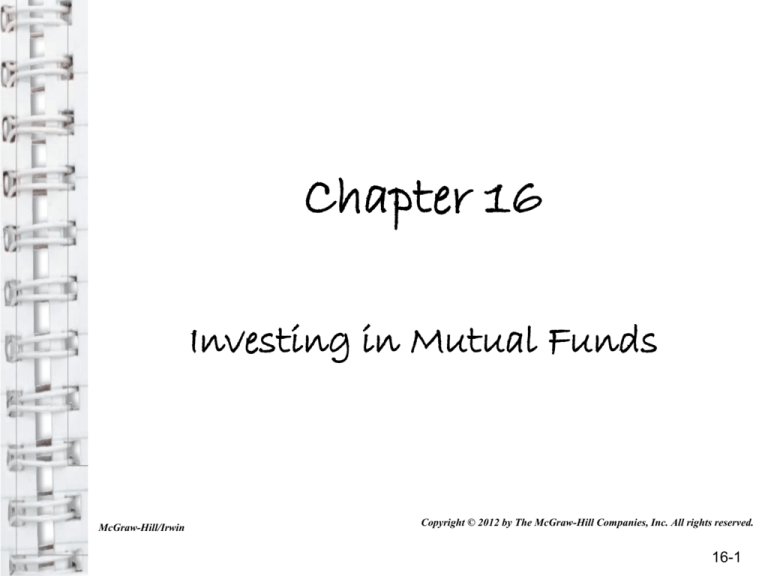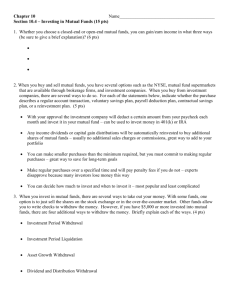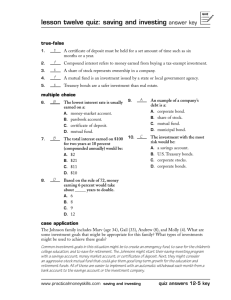
Chapter 16
Investing in Mutual Funds
McGraw-Hill/Irwin
Copyright © 2012 by The McGraw-Hill Companies, Inc. All rights reserved.
16-1
Chapter 16
Learning Objectives
• Describe the characteristics of mutual fund
investments
• Classify mutual funds by investment objective
• Evaluate mutual funds for investment
purposes
• Describe how and why mutual funds are
bought and sold
16-2
Why Investors Purchase
Mutual Funds
Objective 1: Describe the characteristics of
mutual fund investments
• An estimated 87 million individuals own mutual
funds
• Mutual funds grew from 361 in 1970 to over
12,000 in late 2009
• In 2009 the combined value of assets owned by
mutual funds in the United States totaled over
$12.2 trillion
16-3
Why Investors Purchase
Mutual Funds (continued)
• The major reasons investors purchase mutual
funds are:
• Professional management
– Who is the fund’s manager?
– Managers can change
– Be aware of the scandal involving late trading
16-4
Why Investors Purchase
Mutual Funds (continued)
• The major reasons investors
purchase mutual funds are:
(continued)
• Diversification
– Investors funds are used to
purchase a variety of
investments: this variety
provides some safety
16-5
Why Investors Purchase
Mutual Funds (continued)
CHARACTERISTICS OF MUTUAL FUNDS
• Closed-end funds (2% of funds)
– Shares are issued by an investment
company only when the fund is organized
– After all original shares are sold you can
purchase shares only from another
investor who is willing to sell
16-6
Why Investors Purchase
Mutual Funds (continued)
CHARACTERISTICS OF MUTUAL FUNDS
(con’t)
• Exchange-Traded fund
– Fund that invests in the stocks contained in
a specific stock index
16-7
Why Investors Purchase
Mutual Funds (continued)
CHARACTERISTICS OF MUTUAL FUNDS
(con’t)
• Open-end funds (92% of funds)
– Shares are issued and redeemed by the
investment company at the request of
investors
– Investors can buy and sell shares at the
net asset value (NAV)
16-8
Why Investors Purchase
Mutual Funds (continued)
Net Asset Value (NAV)
Value of the fund’s portfolio - Liabilities
Number of shares outstanding
16-9
Why Investors Purchase Mutual
Funds (continued)
LOAD FUNDS AND NO-LOAD FUNDS
• Load Fund
– Investors pay a commission (sales charge) up to
8.5% every time they purchase shares. This is
sometimes called a front load. (Class A shares)
– Average charge is 3-5% for which an investor
can get purchase advice and explanations.
• No-Load Fund
– Investors pay no sales charge up front.
– You deal directly with the fund with 800 numbers
or websites or from discount brokers.
16-10
Why Investors Purchase Mutual
Funds (continued)
LOAD FUNDS AND NO-LOAD FUNDS
• Contingent deferred sales load (back-end load)
(Class B shares)
– Charged upon withdrawal of funds (1-5%)
– Generally decreases on a sliding scale
depending on the number of years shares are
held
16-11
Why Investors Purchase
Mutual Funds (continued)
MANAGEMENT FEES AND OTHER CHARGES
• Management fee
– Charged yearly (0. 5%-1% average) based on a
percentage of the funds asset value
• 12b-1 fees (Class C shares)
– Annual fee to defray distribution and marketing
costs of the fund
– Cannot exceed 1% of a fund’s assets per year
16-12
Why Investors Purchase
Mutual Funds (continued)
MANAGEMENT FEES AND OTHER CHARGES
(continued)
• Expense Ratio consists of the different management
fees and additional fund operating costs for a specific
mutual fund: this fee should not exceed 1 percent
16-13
Classification of Mutual
Funds
Objective 2: Classify mutual funds by investment
objective
• STOCK FUNDS
– Aggressive growth funds buy stocks in small,
fast-growing companies
– Equity income funds invest in stock of
companies with a long history of paying
dividends
– Global stock funds buy stock in companies in
the U.S. and other countries
16-14
Classification of Mutual Funds
(continued)
• STOCK FUNDS (con’t)
– Growth stock funds buy stock in companies
with higher-than-average revenue and earnings
growth
– Index funds buys stocks that mirror an index
– International funds invest in foreign stocks
sold in securities market throughout the world
– Large-cap funds invest in companies with
capitalization of $10 billion or more
16-15
Classification of Mutual Funds
(continued)
• STOCK FUNDS (con’t)
– Mid-cap funds invest in companies with total
capitalization of $2 to $10 billion
– Regional funds buy stock in companies in a
specific region of the world
– Sector funds buy stock in companies in a particular
industry such as biotechnology
– Small-cap funds buy stock in lesser-known
companies with a capitalization of between $300
million and $2 billion
– Socially responsible funds avoid investing in
companies that produce harmful products
16-16
Classification of Mutual Funds
(continued)
• BOND FUNDS
– High-yield (junk) bond funds buy corporate
bonds that are higher risk and higher yield
– Intermediate corporate bonds (5-10 years)
– Intermediate U.S. bond funds buy treasury
notes with maturities of 5-10 years
– Long-term corporate bonds (> 10 years)
16-17
Classification of Mutual Funds
(continued)
• BOND FUNDS (con’t)
– Long-term U.S. bond funds: U.S. Treasury and
U.S. zero-coupon bonds with maturities > than 10
years
– Municipal bonds: Invest in municipal bonds that
provide investors tax-free interest income
– Short-term corporate bond funds: Investment
grade bonds with maturities of 1-5 years
16-18
Classification of Mutual Funds
(continued)
• BOND FUNDS (con’t)
– Short-term U.S. bond funds invest in U.S.
Treasury issues of 1-5 years
– World bond funds buy bonds of foreign
companies and governments
16-19
Classification of Mutual Funds
(continued)
• OTHER FUNDS
– Asset allocation funds: Invest in various asset
classes, such as stocks, and bonds, with
precise amounts within each type
– Balanced funds: Invest in both stocks and
bonds, with the primary objectives of
conserving principal, providing income as well
as growth
16-20
Classification of Mutual Funds
(continued)
• OTHER FUNDS
-Funds of funds: Invest in shares of other mutual
funds
-Lifecycle funds (target date funds): Initially
invest in more risk-oriented securities and become
increasingly conservative and income-oriented as
a specified retirement date approaches
– Money Market funds: Invest in CD’s,
government securities, and other safe
investments
16-21
Classification of Mutual Funds
(continued)
FAMILY OF FUNDS
• A family of funds exists when one
investment company manages a
group of mutual funds
• Each fund in the family has a different
financial objective
• Exchange privileges allow you to
move your money from one fund to
another within the fund family with
little or no charge for the transaction
16-22
How to Decide to Buy or Sell
Mutual Funds
Objective 3: Evaluate mutual funds for
investment purposes
MANAGED FUNDS VERSUS INDEXED FUNDS
• Most mutual funds are managed funds which
means there is a professional fund manager or a
team of managers choosing the investments
• An index mutual fund is the mirror image of a
specific index
16-23
How to Decide to Buy or Sell
Mutual Funds (continued)
MANAGED FUNDS VERSUS INDEXED
FUNDS (con’t)
• Majority of the managed funds have failed to
outperform the S&P 500 index over a long period
of time
• Index funds have a lower expense ratio, typically
around 0.50 percent or less
• Research is the key to determining the best
investment
16-24
How to Decide to Buy or Sell Mutual
Funds (continued)
THE INTERNET
• Use web sites to research a fund.
– http://finance.yahoo.com
– www.businessweek.com
– www.morningstar.com (also other advisory
services, such as Value Line)
– www.smartmoney.com
16-25
How to Decide to Buy or Sell Mutual
Funds (continued)
HOW TO READ THE MUTUAL FUNDS SECTION
OF THE NEWSPAPER
• The fund family and fund name
• Net asset value
• Net Change is the difference between the price
paid for the last share today and the price paid for
the last share on the previous trading day
• Year-to-date percentage of increase or decrease
for a fund
16-26
How to Decide to Buy or Sell
Mutual Funds (continued)
MUTUAL FUND PROSPECTUS
Mutual fund prospectus includes the funds objective and:
– A statement describing the risk factors
– A description of the fund’s past performance
– A statement describing the type of investments in the
fund’s portfolio
– Dividends, distributions and taxes
– Information about the fund’s management
– The process for investors to buy or sell shares
– Services provided to investors
– The turnover ratio of the fund’s investments
– Information on how to open an account
– Performance, investments, assets and liabilities
16-27
How to Decide to Buy or Sell Mutual
Funds (continued)
• FINANCIAL PUBLICATIONS
– Business Week, Forbes, Fortune, Kiplinger's
Personal Finance and Money are sources of
information
– Money Magazine: Investors Guide 2010 includes
information such as the...
•
•
•
•
•
Fund size and type of fund
Actual fund name
Performance over selected time periods
Expense ratio as a percent of assets
Minimum investment required to open an
account
16-28
The Mechanics of a Mutual
Fund Transaction
Objective 4: Describe how and why mutual
funds are bought and sold
• You can open an account from $250 to over
$2,500 depending on the fund & family
• Open-end, no-load funds can be bought directly
from the investment company by phone, mail,
online, or from a discount broker
• Closed-end or exchange-traded funds are
purchased through a securities exchange or in
the over-the-counter market
16-29
The Mechanics of a Mutual Fund
Transaction (continued)
RETURN OF INVESTMENT
– Income dividends: earnings funds pay to
shareholders from dividend and interest income
(Taxed as regular income)
– Capital gains: sell shares at a price > than you
paid (Report directly on Schedule D or Form 1040).
When selling the shares are taxed on a short-term
or long-term basis depending on the length of time
the funds are held
16-30
The Mechanics of a Mutual Fund
Transaction (continued)
RETURN OF INVESTMENT (continued)
– Capital gain distributions: Payments to
shareholders from sale of securities held by the
fund (Show on Schedule D and Form 1040)
These are taxed as long term capital gains
regardless of how long you own shares in the
mutual fund
– Income and capital gain distributions can be
automatically reinvested
16-31
The Mechanics of a Mutual
Fund Transaction (continued)
TAXES AND MUTUAL FUNDS:
• Funds reinvested in the purchase of additional
shares are still taxable
• The “turnover ratio” measures the percentage of
the fund that has been replaced in one year. In
funds that are not tax deferred (401(k) or 403(b)),
this will affect your tax liability
16-32
The Mechanics of a Mutual Fund
Transaction (continued)
PURCHASE OPTIONS
• Automatic investments: Money is taken from your
checking account monthly and invested in a fund
• Reinvestment Plan: Income from dividends and capital
gains distributions are automatically used to
repurchase additional shares
• Telephone Switching: Call your fund and move money
from one fund to another in the same family
• Withdrawals: Various withdrawal options; you can
withdraw funds by phone, letter, online, etc.
16-33







